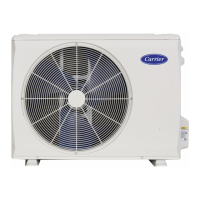Do you have a question about the Carrier 38MBRQ48A-3 and is the answer not in the manual?
Identifies DANGER, WARNING, CAUTION meanings and specific hazards like electrical shock and explosion.
Cautions regarding pipe burial and general equipment handling.
Step-by-step guide on using a vacuum pump to evacuate the system.
Diagram illustrating evaporator coil temperature protection states: Off, Decrease, Hold, Resume.
Lists indoor unit error codes, LED status, and corresponding solutions with page references.
Lists error codes displayed on the wired controller and their solutions.
Table correlating outdoor unit problems with error codes and solutions.
Steps to diagnose and resolve EEPROM parameter errors, including PCB replacement.
Flowchart to diagnose and resolve overload current protection issues.
Steps to diagnose and fix communication errors between indoor and outdoor units.
Flowchart to diagnose and resolve indoor/outdoor fan speed problems.
Steps to diagnose and fix temperature sensor circuit faults.
Flowchart to diagnose and resolve refrigerant leakage detection errors.
Steps to diagnose and resolve IPM or IGBT over-current protection faults.
Flowchart to diagnose and resolve over/under voltage protection issues.
Flowchart to diagnose and resolve compressor top high temperature protection.
Flowchart for diagnosing inverter compressor drive errors.
Steps to diagnose and resolve IPM module temperature sensor faults.
Flowchart for diagnosing and resolving evaporator high temperature protection (J0).
Flowchart for diagnosing and resolving high temperature condenser protection (J1).
Flowchart for diagnosing compressor discharge temperature protection (J2).
Flowchart for diagnosing PFC module protection (J3) issues.
Flowchart for diagnosing communication errors between IPM and main control board (J4).
Flowchart for diagnosing high pressure protection (J5) issues.
Flowchart for diagnosing low pressure protection (J6/P6) issues.
Flowchart for diagnosing AC power input voltage protection (J8) issues.
Identifies DANGER, WARNING, CAUTION meanings and specific hazards like electrical shock and explosion.
Cautions regarding pipe burial and general equipment handling.
Step-by-step guide on using a vacuum pump to evacuate the system.
Diagram illustrating evaporator coil temperature protection states: Off, Decrease, Hold, Resume.
Lists indoor unit error codes, LED status, and corresponding solutions with page references.
Lists error codes displayed on the wired controller and their solutions.
Table correlating outdoor unit problems with error codes and solutions.
Steps to diagnose and resolve EEPROM parameter errors, including PCB replacement.
Flowchart to diagnose and resolve overload current protection issues.
Steps to diagnose and fix communication errors between indoor and outdoor units.
Flowchart to diagnose and resolve indoor/outdoor fan speed problems.
Steps to diagnose and fix temperature sensor circuit faults.
Flowchart to diagnose and resolve refrigerant leakage detection errors.
Steps to diagnose and resolve IPM or IGBT over-current protection faults.
Flowchart to diagnose and resolve over/under voltage protection issues.
Flowchart to diagnose and resolve compressor top high temperature protection.
Flowchart for diagnosing inverter compressor drive errors.
Steps to diagnose and resolve IPM module temperature sensor faults.
Flowchart for diagnosing and resolving evaporator high temperature protection (J0).
Flowchart for diagnosing and resolving high temperature condenser protection (J1).
Flowchart for diagnosing compressor discharge temperature protection (J2).
Flowchart for diagnosing PFC module protection (J3) issues.
Flowchart for diagnosing communication errors between IPM and main control board (J4).
Flowchart for diagnosing high pressure protection (J5) issues.
Flowchart for diagnosing low pressure protection (J6/P6) issues.
Flowchart for diagnosing AC power input voltage protection (J8) issues.












